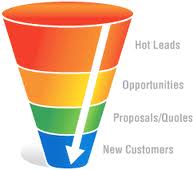 The recent Spotfire on-demand webcast, “What’s Hiding in Your Sales Data?” covers the many challenges faced by sales organizations trying to turn hot leads into new customers.
The recent Spotfire on-demand webcast, “What’s Hiding in Your Sales Data?” covers the many challenges faced by sales organizations trying to turn hot leads into new customers.
The webcast also discusses how Spotfire is used to seamlessly access Salesforce.com data and enhance traditional reporting capabilities.
One of the most common reasons given for higher than anticipated losses in any quarter is that deals in the pipeline fail to close as expected.
Here’s a sample clip from the webcast followed by a post on how data analysis can help companies better manage the sales pipeline.
Big data and analytics are commonly associated with a firm’s marketing efforts. But, data analysis can be crucial to supporting the sales process and providing visibility into a sales pipeline that often can be shrouded because limited information results in decisions fueled by gut feelings instead of being driven by data.
In fact, 71% of the best performing companies have a central repository of financial performance information to ensure that employees across the organization are working from a “single version of the truth,” according to a recent report from Aberdeen research.
In addition, this route allows companies to overcome the problem of silos of information within departments. Aberdeen finds that 50% of the top performing companies have an open exchange of data across business functions.
“Analytical insight in one department can have an impact across multiple client-facing line-of-business,” the report notes. “Dwindling sales figures could lead customer service to reach out and discover unknown issues, or marketing data might prevent salespeople from wasting resources on an already saturated market.”
Additional insights from the report include:
- Fifty-four percent of the top performing companies have a formal definition of progressive sales stages that are used to weigh sales forecasts
- Forty-four percent of companies who say they have formal deal abandonment or deal win/loss analyses in place are the top performing companies in the survey
- The top performing companies are twice as likely as all other companies to measure the effects of deal abandonment, discounting or sales incentives than other companies
But the first step for many companies is identifying the best metrics to put into place to better manage the sales process. And that means companies should focus their data analysis efforts on deal quantity, quality and velocity, according to Paul Vinogradov, vice president with the sales consulting organizations the Alexander Group.
Deal quantity involves the number of leads, number of deals and the value of the pipeline in terms of expected value for a specific period of time, he notes.
“Quality metrics are more difficult to measure but using them adds a critical lens to the effectiveness of the sales process,” Vinogradov says. “Are leads qualified effectively? Are deal sizes and types attractive? Close rate is the classic quality metric. Win/loss analysis can provide valuable insights into strengths and weaknesses of your sales effort and the advantages or shortcomings of your offerings.”
Finally, deal velocity measures the turnover of deals, or how quickly a lead moves through the sales funnel after it appears.
“How much time in both total duration and in actual rep selling hours does closing the deal require? You can gain valuable insights from assessing where deals get hung up in the process and what constraints, both internal and external, may be causing this,” he adds. “The number one shortfall for most sales forces is the reluctance to qualify out deals.”
Next Steps:
- Subscribe to our blog to stay up to date on the latest insights and trends in data analysis and sales.






